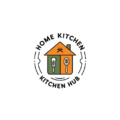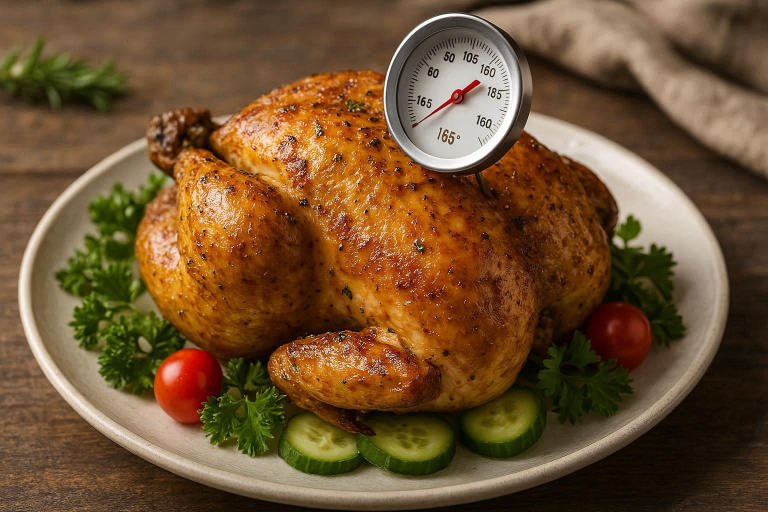Chicken is one of the most versatile and popular meats, but cooking it properly is essential for both food safety and flavor. Undercooked chicken can lead to dangerous foodborne illnesses like Salmonella and Campylobacter, while overcooking can result in dry, flavorless meat. So, what temperature should chicken be cooked to?
In this blog post, we’ll dive into the right internal temperature for chicken, how to measure it accurately, common cooking mistakes, and tips to ensure your chicken comes out perfectly every time. Whether you’re cooking chicken breasts, thighs, or a whole chicken, this guide will help you get it just right.
Why Cooking Chicken to the Right Temperature is Crucial
Food Safety and Avoiding Illness
Undercooking chicken is a significant health risk. Raw or undercooked poultry can contain harmful bacteria like Salmonella or Campylobacter, which can cause serious foodborne illnesses. Cooking chicken to the right temperature ensures that any harmful bacteria are killed, making the chicken safe to eat. The U.S. Department of Agriculture (USDA) recommends cooking all poultry to an internal temperature of 165°F (74°C) to guarantee it’s safe for consumption.
The Role of Temperature in Tenderness and Juiciness
Apart from safety, cooking chicken to the right temperature is key to achieving the perfect texture. Undercooking chicken results in raw or mushy meat, while overcooking leads to dry, tough chicken that lacks flavor. When chicken Guide to Mastering Everyday Cooking reaches its ideal internal temperature, it retains moisture, creating juicy, tender meat. This is especially crucial for chicken breasts, which can dry out easily if cooked beyond their optimal temperature.
The Safe Internal Temperature for Chicken
Recommended Internal Temperature for Whole Chicken
When cooking a whole chicken, it’s important to check the temperature in multiple places, as different parts of the chicken cook at different rates. The USDA recommends cooking a whole chicken to an internal temperature of 165°F (74°C) at the thickest part of the breast, thigh, and wing. For even cooking, it’s best to check in both the breast and the thigh.
- Tip: If the breast is at 165°F but the thigh is lower, keep cooking until both parts reach the recommended temperature.
Internal Temperature for Chicken Breasts
Chicken breasts should also be cooked to 165°F (74°C). Since chicken breasts are leaner than dark meat, they can dry out quickly if overcooked. Reaching 165°F ensures the meat stays moist, tender, and fully cooked without becoming rubbery or dry.
- Tip: For best results, cook chicken breasts on medium heat, whether you’re pan-searing, baking, or grilling.
Internal Temperature for Chicken Thighs and Drumsticks
Chicken thighs and drumsticks are darker, fattier cuts, and they’re more forgiving than breasts when it comes to cooking time. While 165°F (74°C) is the safe minimum, cooking thighs and drumsticks to 170-175°F (77-80°C) will yield more tender, juicy meat. The higher temperature breaks down the collagen and fat, resulting in a richer texture.
- Tip: For crispy skin, try finishing the thighs or drumsticks under a broiler for a few minutes once they’ve reached the proper internal temperature.
Ground Chicken or Chicken Sausage
Ground chicken, like chicken sausage or ground chicken patties, needs to reach 165°F (74°C) internally. Ground meat can be more susceptible to bacteria, which is why it’s essential to cook it thoroughly to ensure food safety.
- Tip: Use a thermometer to avoid undercooking ground chicken, which can sometimes appear cooked on the outside while still raw in the middle.
How to Accurately Measure Chicken Temperature
Using a Meat Thermometer
The best way to ensure your chicken is cooked properly is by using a digital instant-read meat thermometer. Here’s how to use it:
- Insert the thermometer into the thickest part of the chicken, avoiding any bones, which can give false readings.
- Wait for the reading: Most digital thermometers provide a temperature in 5 seconds or less. For optimal results, make sure you check the thickest part of the chicken.
- Check multiple areas if you’re cooking a whole chicken, especially the breast and thigh.
When to Check the Temperature
It’s crucial to check the temperature towards the end of the cooking process. Chicken cooks quickly, and you don’t want to overcook it. You can start checking for doneness a few minutes before the estimated cooking time is up.
- Tip: Check doneness in various chicken parts to ensure even cooking. Remember that larger cuts, like thighs, may need a few more minutes to cook through completely.
Common Mistakes When Cooking Chicken to the Right Temperature
Not Allowing for Carryover Cooking
Carryover cooking occurs when you remove the chicken from heat, but it continues to cook due to residual heat. For example, if you pull your chicken out of the pan at 160°F, the temperature will continue to rise to 165°F while resting. Always remove the chicken from heat a few degrees before it reaches the target temperature.
- Tip: Let your chicken rest for a few minutes after cooking to allow carryover cooking and ensure a juicy final product.
Relying on Visual Cues Alone
You may have heard that you can tell when chicken is done by its color or when the juices run clear. While these methods can be helpful, they’re not foolproof. The safest way to check doneness is by using a thermometer.
- Tip: Don’t rely on just visual cues. Always use a thermometer for the most accurate results.
Not Resting the Chicken After Cooking
Letting chicken rest for about 5 minutes after cooking helps redistribute the juices within the meat. Cutting into chicken immediately after cooking will cause all the juices to run out, resulting in dry meat. Resting helps maintain moisture and improves flavor.
Tips for Cooking Perfect Chicken Every Time
How to Cook Chicken Breasts
Chicken breasts are lean and prone to drying out. To keep them juicy and tender:
- Pan-searing: Cook chicken breasts over medium heat, searing both sides for 2-3 minutes, then finish in the oven if needed.
- Baking: Bake chicken breasts at 375°F for about 20-25 minutes, checking internal temperature at the thickest part.
- Brining or Marinating: Soaking chicken breasts in a brine or marinade can add moisture and flavor, helping to prevent dryness.
How to Cook Chicken Thighs
Chicken thighs are more forgiving and remain moist even when slightly overcooked. To get crispy skin and juicy meat:
- Grilling: Grill over medium heat for 6-8 minutes per side.
- Oven-Roasting: Roast thighs at 400°F for 35-40 minutes, checking for an internal temperature of 170-175°F for optimal tenderness.
Baking vs. Grilling: Temperature Considerations
- Baking: Bake chicken breasts at 375°F and thighs at 400°F for crispy skin and juicy meat.
- Grilling: Chicken cooks faster on the grill, so check the temperature regularly. Use indirect heat for thicker cuts like bone-in thighs.
How to Tell If Chicken is Done Without a Thermometer
If you don’t have a thermometer, there are other ways to check if your chicken is done:
Using the Knife Test
Cut into the thickest part of the chicken. If the juices run clear, the chicken is done. If the juices are pink or red, the chicken needs more time.
The Fork Test
Gently pull the chicken apart with a fork. If the meat easily flakes, it’s done. If it’s tough or resists pulling, it needs more time.
Other Visual Clues
Golden, crispy skin, along with firm, opaque meat, can indicate that your chicken is properly cooked. However, the best method still uses a thermometer.
Resting Your Chicken: Why It Matters
Understanding Carryover Cooking and Resting Time
Letting your chicken rest after cooking is just as important as cooking it to the right temperature. During the resting time, the internal temperature continues to rise slightly due to carryover cooking. Resting also helps redistribute the juices throughout the meat, keeping it moist.
- Resting Times: For smaller cuts, let them rest for 5 minutes. For a whole chicken, rest it for up to 10 minutes.
FAQ
Q: Can chicken be slightly pink at 165°F?
Yes, it’s safe to eat chicken that’s slightly pink at 165°F, especially in the breast. As long as the chicken reaches the recommended internal temperature, it’s safe.
Q: What is the best tool to measure chicken’s temperature?
A digital instant-read thermometer is the most accurate and reliable tool for measuring the internal temperature of chicken.
Q: Can I cook chicken at a lower temperature?
It’s possible, but it will require longer cooking times. Always ensure the chicken reaches 165°F (74°C) for safety and proper texture.
Q: How do I know when chicken thighs are done?
For best texture, chicken thighs should reach 170-175°F (77-80°C). They are more forgiving than breasts, but they still need to reach the right temperature for optimal flavor and tenderness.
Q: Why is my chicken always dry?
Dry chicken usually results from overcooking. Use a thermometer to check the internal temperature and avoid overcooking your chicken.
Conclusion
Cooking chicken to the right temperature is essential for both food safety and the quality of the meat. By using a thermometer, avoiding common mistakes, and applying the right techniques, you can enjoy juicy, flavorful chicken every time. Don’t be afraid to experiment with different cuts and cooking methods. Share your tips and experiences in the comments below—we’d love to hear how your chicken turns out!

